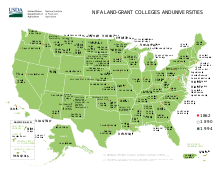
Iowa State University of Science and Technology is a public land-grant research university in Ames, Iowa. Founded in 1858 as the Iowa Agricultural College and Model Farm, Iowa State became one of the nation's first designated land-grant institutions when the Iowa Legislature accepted the provisions of the 1862 Morrill Act on September 11, 1862, making Iowa the first state in the nation to do so. On July 4, 1959, the college was officially renamed Iowa State University of Science and Technology.

The Morrill Land-Grant Acts are United States statutes that allowed for the creation of land-grant colleges in U.S. states using the proceeds from sales of federally owned land, often obtained from Native American tribes through treaty, cession, or seizure. The Morrill Act of 1862 was enacted during the American Civil War, and the Morrill Act of 1890 expanded this model.
Separate but equal was a legal doctrine in United States constitutional law, according to which racial segregation did not necessarily violate the Fourteenth Amendment to the United States Constitution, which nominally guaranteed "equal protection" under the law to all people. Under the doctrine, as long as the facilities provided to each race were equal, state and local governments could require that services, facilities, public accommodations, housing, medical care, education, employment, and transportation be segregated by race, which was already the case throughout the states of the former Confederacy. The phrase was derived from a Louisiana law of 1890, although the law actually used the phrase "equal but separate".

The New York State College of Agriculture and Life Sciences at Cornell University is one of Cornell University's four statutory colleges, and is the only College of Agriculture and Life Sciences in the Ivy League. With enrollment of approximately 3,100 undergraduate and 1,000 graduate students, CALS is Cornell's second-largest undergraduate college and the third-largest college of its kind in the United States.

Justin Smith Morrill was an American politician and entrepreneur who represented Vermont in the United States House of Representatives (1855–1867) and United States Senate (1867–1898). He is most widely remembered for the Morrill Land-Grant Acts that provided federal funding for establishing many of the United States' public colleges and universities. Originally a Whig, after that party became defunct Morrill was one of the founders of the Republican Party.

Texas A&M AgriLife Extension Service was formally established in 1915 after the 1914 passing of the Smith-Lever Act and in conjunction with Texas A&M University. Originally named Texas Agricultural Extension Service, then later Texas Cooperative Extension, the name Texas AgriLife Extension Service was adopted on January 1, 2008. A&M was added to the agency name on September 1, 2012 as a result of a Texas A&M University System change to strengthen the association with Texas A&M. The primary mission of AgriLife Extension is to provide educational outreach programs and services to the citizens of Texas. In conjunction with Texas A&M AgriLife Research, the Extension faculty members conduct research and bring practical applications of those research findings to the people of Texas.
The history of Michigan State University dates back to 1855, when the Michigan Legislature established the Agricultural College of the State of Michigan under the encouragement of the Michigan State Agricultural Society and the Michigan Farmer, the state's leading agricultural periodical. As the first agricultural college in the United States, the school served as a model for other institutions of its kind established in the period, to give an instance, the Agricultural College of Pennsylvania.

New Hampshire College of Agriculture and the Mechanic Arts (NHC) was founded and incorporated in 1866, as a land grant college in Hanover in connection with Dartmouth College. In 1893, NHC moved to Durham, where it became the University of New Hampshire (UNH) in 1923, by an act of the New Hampshire General Court.

The Association of American Universities (AAU) is an organization of American research universities devoted to maintaining a strong system of academic research and education. Founded in 1900, it consists of 69 public and private universities in the United States as well as two universities in Canada. AAU membership is by invitation only and requires an affirmative vote of three-quarters of current members.

The University of Florida Institute of Food and Agricultural Sciences (UF/IFAS) is a teaching, research and Extension scientific organization focused on agriculture and natural resources. It is a partnership of federal, state, and county governments that includes an Extension office in each of Florida's 67 counties, 12 off-campus research and education centers, five demonstration units, the University of Florida College of Agricultural and Life Sciences, three 4-H camps, portions of the UF College of Veterinary Medicine, the Florida Sea Grant program, the Emerging Pathogens Institute, the UF Water Institute and the UF Genetics Institute.

The New Jersey Agricultural Experiment Station is an entity currently operated by Rutgers, The State University of New Jersey in conjunction with the State of New Jersey in the university's role as the state's sole land-grant university. Today, it conducts research in agriculture, horticulture and turf grass science, and through the Rutgers Cooperative Extension aids New Jersey farmers, landscapers, and residents in each of the state's twenty-one counties.
The Association of Public and Land-grant Universities (APLU) is a research, policy, and advocacy organization of public research universities, land-grant institutions, state university systems, and higher education organizations. It has member campuses in all of the United States as well as the District of Columbia, four U.S. territories, Canada, and Mexico.

New Jersey Hall is a historic education building located on the campus of Rutgers University in New Brunswick, New Jersey. Built in 1889 under the leadership of President Merrill Edward Gates, it housed the Agricultural Experiment Station. It was added to the National Register of Historic Places on February 24, 1975, for its significance in agriculture and education.
The history of North Carolina Agricultural and Technical State University, the first land grant college for people of color in the state of North Carolina, can be traced back to 1890, when the United States Congress enacted the Second Morrill Act which mandated that states provide separate colleges for the colored race. The "Agricultural and Mechanical College for the Colored Race" was established On March 9, 1891 by an act of the General Assembly of North Carolina and began in Raleigh, North Carolina as an annex to Shaw University. The college made a permanent home in Greensboro with the help of monetary and land donation by local citizens. The college granted admission to both men and women from 1893 to 1901, when the board of trustees voted to restrict admission to males only. This policy would remain until 1928, when female students were once again allowed to be admitted.

The Cooperative State Research, Education, and Extension Service (CSREES) was an extension agency within the U.S. Department of Agriculture (USDA), part of the executive branch of the federal government. The 1994 Department Reorganization Act, passed by Congress, created CSREES by combining the former Cooperative State Research Service and the Extension Service into a single agency.
The history of higher education in the United States begins in 1636 and continues to the present time. American higher education is known throughout the world for its dramatic expansion. It was also heavily influenced by British models in the colonial era, and German models in the 19th century. The American model includes private schools, mostly founded by religious denominations, as well as universities run by state governments, and a few military academies that are run by the national government.
Richard Baxter Foster was an American abolitionist, Union Army officer, and initial head of a college for African Americans in Jefferson City, Missouri. During the American Civil War, Foster volunteered to be an officer for the 1st Missouri Regiment of Colored Infantry regiment of the U.S. Army, largely recruited in Missouri, and helped set up educational program for its soldiers. In 1866 Foster headed the new college in Jefferson City, the Lincoln Institute, with financial support from his former regiment. The college is now named Lincoln University.
Roger L. Geiger is an American scholar of higher education in the United States. He is Distinguished Professor of Higher Education Emeritus at Pennsylvania State University.

In the United States, governmental entities at all levels- including townships, cities, counties, states, and the federal government- all manage land which are referred to as either public lands or the public domain.













